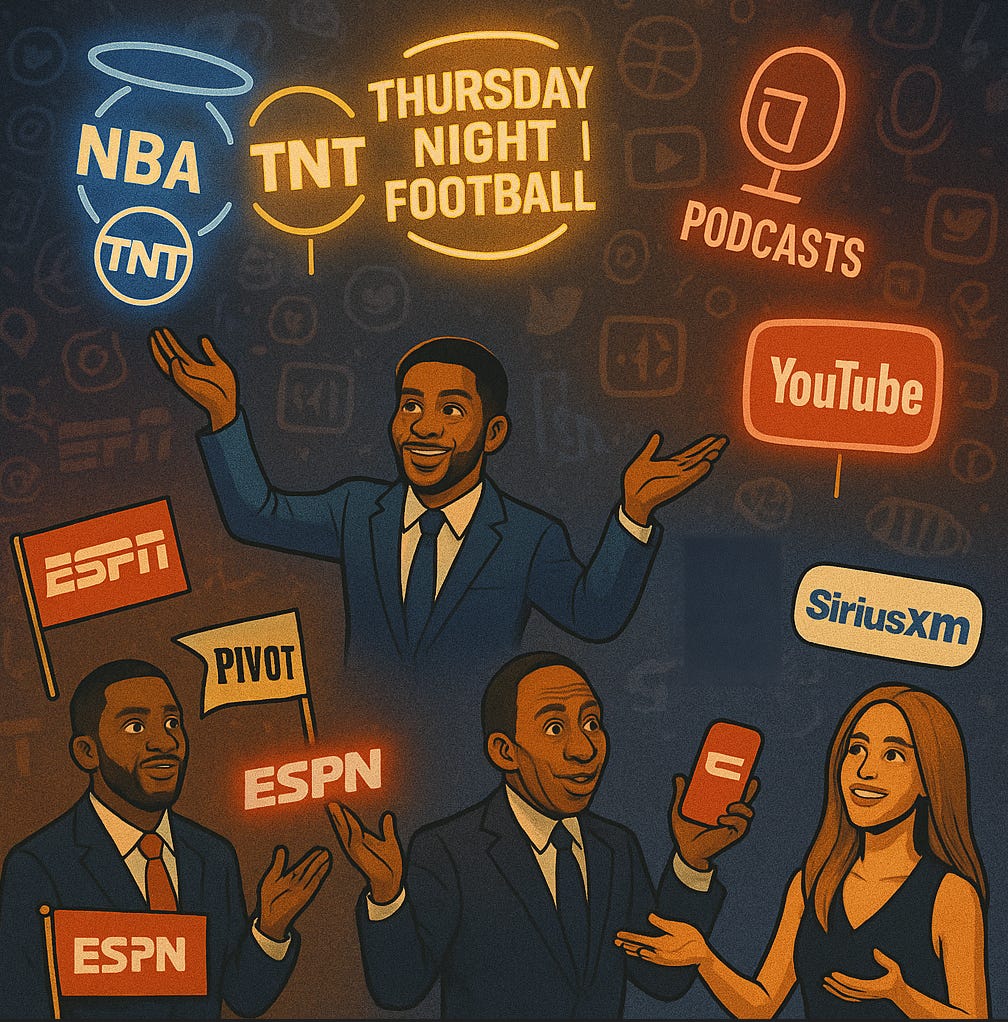The Multi-Hyphenate Dilemma: How Many Jobs Is Too Many in Sports Media?
In 2025, the problem isn’t that sports media pros have too many jobs—it’s that companies still expect them to have just one.
In today’s sports media world, it’s almost impossible to do just one thing.
You don’t just host a show, you podcast, you go live on YouTube, you take branded deals, you drop reels on TikTok, maybe you sideline report on weekends, maybe you run your own media company.
Being a multi-hyphenate isn’t a luxury. It’s the job.
So when Rachel DeMita, who runs Courtside Club on YouTube and regularly covers the WNBA got fired from her Big3 sideline role for tweeting a Caitlin Clark highlight during a Big3 game, it raised an uncomfortable question:
Are we punishing people for doing what it takes to stay relevant?
Let’s be clear:
It wasn’t a random tweet. DeMita has covered Clark.
The game had a stoppage.
And if you think attention spans are long enough to “stay locked in” on courtside blowouts for 3 straight hours, you haven’t been to a Big3 game lately.
Yet she’s out. Meanwhile, Stephen A. Smith literally got caught playing solitaire on-air during the NBA Finals and keeps climbing the ladder FanDuel deal, SiriusXM show, ESPN's face of debate.
The contradiction reveals something deeper.
The New Sports Media Math
Most of today’s top talents have multiple jobs:
Taylor Rooks does NBA on TNT, Thursday Night Football, Bleacher Report, and podcast work.
Ryan Clark is both an ESPN analyst and a key figure at The Pivot.
Stephen A. has ESPN, FanDuel, SiriusXM.
DeMita was trying to navigate her own lane, creator-style.
So where exactly is the line? If you’re not an ESPN monolith, are you expected to shut off your other platforms? Mute your POV? Clock out from being a creator?
And what message does this send to rising talent who are forced to build diversified media careers because no one company is offering them stability or full-time pay?
The Big3 Missed the Point
DeMita’s tweet wasn’t a distraction. It was a distribution moment.
Any smart league today should want its on-air talent building personal reach, especially one like Big3, which thrives on culture but doesn’t have strong mainstream tune-in.
Instead, they chose to gatekeep relevance.
The irony? A Caitlin Clark crossover moment might’ve been the best chance Big3 had to ride the algorithm. Instead, they punished someone for playing the game better than they did.
Stop Hunting. Start Creating.
Content managers waste 3-6 weeks a year just finding the right clip. While you're digging through folders named "misc_highlights_final_v3," competitors are posting your story.
WSC Sports’ Asset Management kills the treasure hunt. AI that actually understands sports - not just “ball detected” - tags every frame with player, play type, and context the second it hits your library. That buzzer-beater? Already cropped for Instagram Stories. That celebration? Ready for TikTok.
Partners get their own portal instead of blowing up your Slack. You can upload from the tunnel on mobile. And everything connects to automated content creation, so finding assets becomes using assets.
Your best content is already shot. Stop losing to people who just find it faster.
Disruptive Play: How many jobs is too many for a sports media professional in 2025?
The real answer might be: as many as it takes to stay relevant. The media landscape has shifted from company men to personal brands. If you’re not diversifying, you’re dying. But legacy orgs still expect exclusivity—without offering the compensation or upside that once justified it.
Should creators be expected to pause their personal brands when they’re on assignment for others?
Only if those companies are willing to treat them like full-time talent and pay accordingly. Otherwise, it’s unreasonable to ask someone to silence their identity, especially when that identity is why they were hired in the first place. You don’t get creator reach without creator autonomy.
Will companies stop hiring multi-hyphenates out of fear their attention is too divided?
They might try. But they’ll quickly realize that the people who can move culture always have something else going on. The best voices in sports media today don’t fit in one box—they bounce between formats, audiences, and platforms. Hiring a multi-hyphenate isn’t a liability. It’s a growth strategy—if you get out of the way.
Or will they finally realize that divided attention = multiplied distribution?
This is the unlock. The same tweet that gets someone fired could be the one that drives attention to your league. The same creator you worry “isn’t focused” might be the reason a younger demo even knows your product exists. Letting talent be talent is the cheat code.
FINAL THOUGHTS
And maybe the real question: Was this ever actually a problem or are we just now noticing because creators have more power than platforms?
In the newspaper age, columnists wrote books. TV anchors hosted speaking gigs. It’s just that distribution was centralized, and visibility was limited. Now that creators own the feed, companies can’t control the narrative and that’s making some of them deeply uncomfortable.






